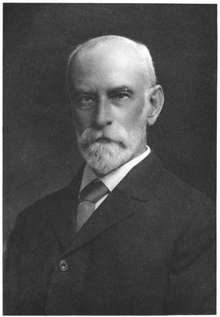Charles Sedgwick Minot
Charles Sedgwick Minot (December 23, 1852 – November 19, 1914) was an American anatomist and a founding member of the American Society for Psychical Research.[1]
Charles Sedgwick Minot | |
|---|---|
 | |
| Born | December 23, 1852 |
| Died | November 19, 1914 |
| Occupation | Anatomist, writer |
Life
Charles Sedgwick Minot was born December 23, 1852 in Roxbury, Massachusetts. His mother was Catharine "Kate" Maria Sedgwick (1820–1880) and father was William Minot II (1817–1894).[2] Through his mother, namesake of her aunt, novelist Catharine Sedgwick (1789–1867), he was twice connected to the New England Dwight family of academics.[3]
He graduated from the Massachusetts Institute of Technology in 1872, studied biology at Leipzig, Paris, and Würzburg. At Harvard Medical School he taught from 1880 till his death as the James Stillman Professor of comparative anatomy in 1905 and director of the anatomical laboratories in 1912.
He was president of the American Association for the Advancement of Science in 1901, and of the Association of American Anatomists from 1904 to 1905, and was corresponding member of various foreign societies.
Honorary degrees were conferred on him by Yale University, the University of Toronto, St. Andrews, and Oxford. From 1912 to 1913 he served as Harvard exchange professor at Berlin and Jena. He died on November 19, 1914 in Milton, Massachusetts.
His cousin once removed, George Richards Minot (1885–1950), named for his great-grandfather George Richards Minot (1758–1802),[4] shared the Nobel Prize in Medicine in 1934.[5]
Minot was a founding member of the American Society for Psychical Research. He later resigned due to its unscientific outlook.[6][7] He was highly critical of Alfred Percy Sinnett's Esoteric Buddhism and the claims of Theosophy.[8]
Publications
In addition to many papers and monographs, his publications include:
- Human Embryology (1897), also in German
- A Laboratory Text-Book of Embryology (1903; second edition, 1910)
- The Problem of Age, Growth, and Death (1908)
- Die Methode der Wissenschaft (1913)
- Modern Problems of Biology (1913), also in French
References
- Lewis, Frederick T. (1914). Charles Sedgwick Minot — Dec. 23, 1852 — Nov. 19, 1914. The Boston Medical and Surgical Journal 171: 911-914.
- "Sedgwick Family Papers 1717-1946 Guide to the Collection". Massachusetts Historical Society. Retrieved February 4, 2011.
- Benjamin Woodbridge Dwight (1874). The history of the descendants of John Dwight, of Dedham, Mass. 2. J. F. Trow & son, printers and bookbinders. pp. 853–854.
- "Hon, William Minot". Memoir read at a meetingof the Massachusetts Historical Society: 302–306. March 12, 1874.
- Robert A. Kyle; Marc A. Shampo (November 2002). "George R. Minot—Nobel Prize for the treatment of pernicious anemia". Mayo Clinic Proceedings. 77 (11): 1150. doi:10.4065/77.11.1150. ISSN 0025-6196. PMID 12440548.
- "Charles Sedgwick Minot". Complete Dictionary of Scientific Biography. "For a few years he was active in the American Society for Psychical Research, from which he withdrew when finally convinced of its unscientific outlook."
- Derby, George; White, James Terry. (1929). The National Cyclopædia of American Biography. J. T. White Company. p. 112. "He was actively instrumental in founding the American Society for Psychical Research, and for several years was prominent in its work; but having become convinced of the fallacy of many theories advanced by the parent society in London, he withdrew from active participation."
- Minot, Charles Sedgwick. (1895). The Psychical Comedy. North American Review 160 (459): 217-230.
Further reading
- Edward S. Morse. (1920). Biographical Memoir of Charles Sedgwick Minot, 1852-1914. National Academy of Sciences.
External links
| Wikisource has original works written by or about: Charles Sedgwick Minot |
- Charles Sedgwick Minot — Biographical Memoirs of the National Academy of Sciences
- Charles Sedgwick Papers personal correspondence of the interrelated Sedgwick and Minot families, 1812-1908, Massachusetts Historical Society
- This article incorporates text from a publication now in the public domain: Gilman, D. C.; Peck, H. T.; Colby, F. M., eds. (1905). New International Encyclopedia (1st ed.). New York: Dodd, Mead. Missing or empty
|title=(help)